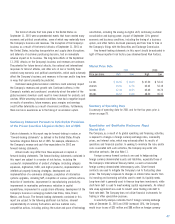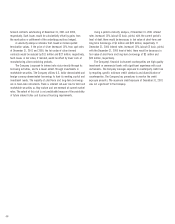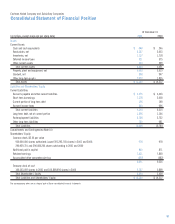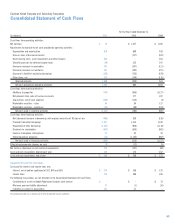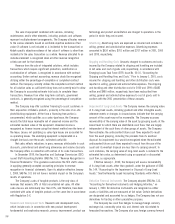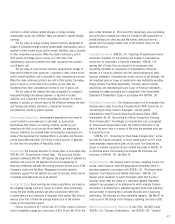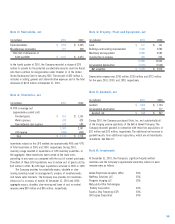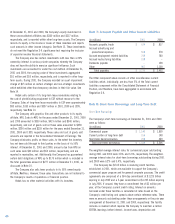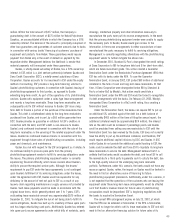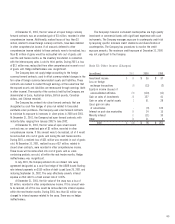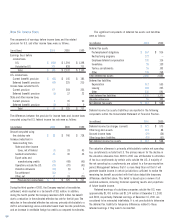Kodak 2001 Annual Report Download - page 59
Download and view the complete annual report
Please find page 59 of the 2001 Kodak annual report below. You can navigate through the pages in the report by either clicking on the pages listed below, or by using the keyword search tool below to find specific information within the annual report.
contracts to offset currency-related changes in foreign currency
denominated assets and liabilities; these are marked to market through
earnings.
The fair value of foreign currency forward contracts designated as
hedges of forecasted foreign currency denominated intercompany sales is
reported in other current assets and/or current liabilities, and is recorded
in other comprehensive income. When the related inventory is sold to
third parties, the hedge gains or losses as of the date of the
intercompany sale are transferred from other comprehensive income to
cost of goods sold.
The fair value of silver forward contracts designated as hedges of
forecasted worldwide silver purchases is reported in other current assets
and/or current liabilities, and is recorded in other comprehensive income.
When the silver-containing products are sold to third parties, the hedge
gains or losses as of the date of the purchase of raw silver are
transferred from other comprehensive income to cost of goods sold.
The fair value of the interest rate swap designated as a hedge of
forecasted floating-rate interest payments is reported in current
liabilities, and is recorded in other comprehensive income. As interest
expense is accrued, an amount equal to the difference between the fixed
and floating-rate interest payments is transferred from other
comprehensive income to interest expense.
Environmental Expenditures Environmental expenditures that relate to
current operations are expensed or capitalized, as appropriate.
Expenditures that relate to an existing condition caused by past
operations and that do not provide future benefits, are expensed as
incurred. Liabilities are recorded when environmental assessments are
made or the requirement for remedial efforts is probable, and the costs
can be reasonably estimated. The timing of these accruals is generally
no later than the completion of feasibility studies.
Income Taxes The Company accounts for income taxes in accordance with
SFAS No. 109, “Accounting for Income Taxes.” The asset and liability
approach underlying SFAS No. 109 requires the recognition of deferred tax
liabilities and assets for the expected future tax consequences of
temporary differences between the carrying amounts and tax basis of the
Company’s assets and liabilities. Management provides valuation
allowances against the net deferred tax asset for amounts which are not
considered more likely than not to be realized.
Earnings Per Share Basic earnings-per-share computations are based on
the weighted-average number of shares of common stock outstanding
during the year. Diluted earnings-per-share calculations reflect the
assumed exercise and conversion of employee stock options that have an
exercise price that is below the average market price of the common
shares for the respective periods.
Options to purchase 43.7 million and 32.3 million shares of common
stock at weighted-average per share prices of $61.30 and $61.98 for the
years ended December 31, 2001 and 2000, respectively, were outstanding
during the years presented but were not included in the computation of
diluted earnings per share because the options’ exercise price was
greater than the average market price of the common shares for the
respective periods.
Comprehensive Income SFAS No. 130, “Reporting Comprehensive Income,”
establishes standards for the reporting and display of comprehensive
income and its components in financial statements. SFAS No. 130
requires that all items that are required to be recognized under
accounting standards as components of comprehensive income be
reported in a financial statement with the same prominence as other
financial statements. Comprehensive income consists of net earnings, the
net unrealized gains or losses on available-for-sale marketable securities,
foreign currency translation adjustments, minimum pension liability
adjustments and unrealized gains and losses on financial instruments
qualifying for hedge accounting and is presented in the Consolidated
Statement of Shareholders’ Equity in accordance with SFAS No. 130.
Stock-Based Compensation The Company accounts for its employee stock
incentive plans under Accounting Principles Board (APB) Opinion No. 25,
“Accounting for Stock Issued to Employees” and the related
interpretations under Financial Accounting Standards Board (FASB)
Interpretation No. 44, “Accounting for Certain Transactions Involving
Stock Compensation.” Accordingly, no compensation cost is recognized
for stock-based compensation unless the quoted market price of the
stock at the grant date is in excess of the price the employee must pay
to acquire the stock.
SFAS No. 123, “Accounting for Stock-Based Compensation,” allows,
but does not require, companies to record compensation cost for stock-
based employee compensation plans at fair value. The Company has
chosen to continue using the intrinsic method prescribed in APB No. 25
as described above. The Company has adopted the disclosure-only
provisions of SFAS No. 123. See Note 18.
Segment Reporting The Company reports net sales, operating income, net
income, certain expense, asset and geographical information about its
operating segments in accordance with SFAS No. 131, “Disclosures about
Segments of an Enterprise and Related Information.” SFAS No. 131
requires public companies to report information about their business
activities, which meet the criteria of a reportable segment. Reportable
segments are components of an enterprise for which separate financial
information is available that is evaluated regularly by the chief operating
decision maker in deciding how to allocate resources and in assessing
performance. The Company has three reportable segments. See Note 21 for
a discussion of the change in the Company’s operating structure in 2001.
Recently Issued Accounting Standards In June 2001, the FASB issued
SFAS No. 141, “Business Combinations,” and SFAS No. 142, “Goodwill
57


